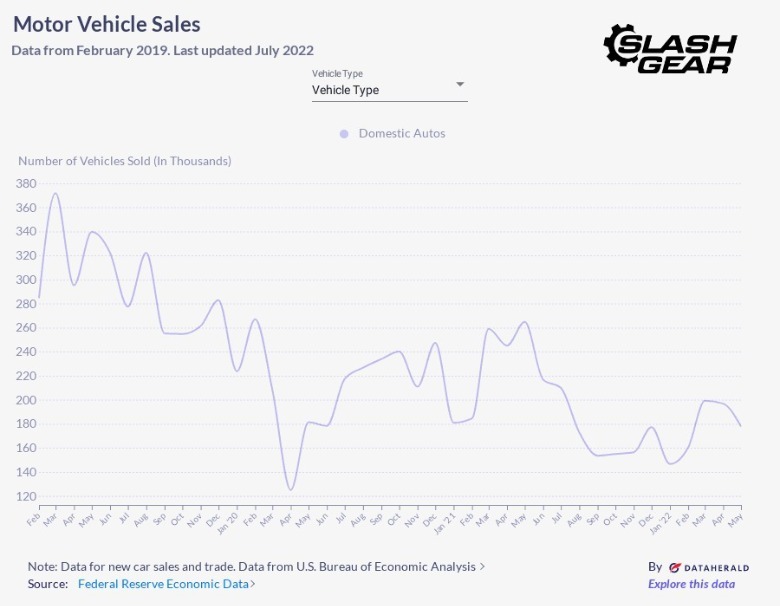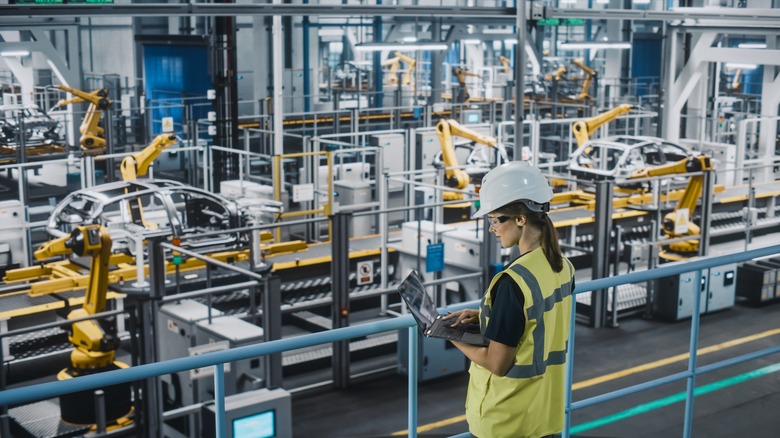Domestic Car Sales Have Gone Through A Steep Decline Since COVID
A car is an everyday part of American life. Unlike older countries that have street maps going back centuries, the United States largely developed alongside the automobile. Its cities tend to be designed to ease navigation and handle heavy traffic — featuring wide streets and grid systems. Then there are zoning regulations that mean people's houses aren't common in the same area as stores, workplaces, and entertainment venues. So transport is important, and personal transport is king. According to Bankrate, there are more than 272 million privately owned vehicles in the United States. That's enough cars for around 85% of the population, and it dwarfs the number of publicly owned vehicles like buses.
Some of the world's biggest motoring manufacturers also call the United States home. Detroit, commonly referred to as "Motor City," birthed the likes of Ford, Chrysler, and General Motors. There are also classic names like Pontiac, Buick, and Cadillac — as well as newer businesses like Tesla and Lucid that are driving towards the future with their focus on the electric vehicle market.
All of this means vehicle manufacturing and sales are a key part of the American economy, which makes the decline in sales over the last couple of years a concern. A number of global crises have contributed to the drop, but is the pandemic the whole story? And has demand declined due to the rapid changes society has undergone in that time? Data obtained by SlashGear suggests things aren't going well in the automotive industry.
Data shows a huge dip in auto sales
Sales statistics compiled by DataHerald for SlashGear show a strong decline in the number of vehicle sales over the last few years. Some sales traditions, like a January dip followed by a strong spring sales period as tax returns hit people's bank accounts, are apparent in the data we received. An interesting thing to note is how the annual January drop seemed to be more severe in 2021. January 2020 saw a drop of around 60,000 sales when compared to the previous month, and sales declined by roughly the same number between December 2020 and January 2021. However, due to the lower sales volume overall, the dip appears to be more severe on the chart and is drastically larger if you look at it as a percentage of sales instead of raw sales numbers.
As you may expect, the biggest dip in sales occurred at the height of the April 2020 lockdown. During this period, sales figures dipped below 125,000. This is likely because many showrooms and dealerships were closed, which meant there were fewer locations where you could actually purchase a car. Unfortunately, despite a brief recovery throughout the second half of 2020 and the first half of 2021, sales numbers never got back to pre-pandemic figures. Since May 2021 we've witnessed a steep decline that threatens to drop sales figures as low as they were at the height of the pandemic. In May 2022, sales were below 180,000 again, with no signs of the downward trend reversing.
The pandemic isn't the main factor affecting sales
By the end of 2021, it was clear that the pandemic had not reduced demand for new vehicles. Unfortunately for manufacturers, they were unable to meet that demand because of another global crisis. The worldwide semiconductor shortage has affected everything from the price of gaming computers and consoles, to the availability of everyday electronics, to vehicle manufacturing. Although a car is in essence a mechanical device, a modern vehicle has a lot of electrical components. Semiconductors are needed for everything from the computer that controls how the engine fires, to the one that controls your electric windows.
The shortage led to situations where manufacturers like GM had 95,000 vehicles sitting assembled but useless as the components needed to finish them were simply not available. The motoring giant was also forced to close manufacturing plants due to shortages and redesign one of its most popular products. The manufacturer decided to simplify the design of the 2022 Ram 1500 in an attempt to get as many as possible off the production line while components were still scarce. Most of the changes affected the quad-cab version of the truck, and included things like a lack of a sun roof, air suspension, and power running boards.
Ford also heavily trimmed production at all of its North American factories as the chip shortage began to bite. The manufacturing of some of Ford's biggest models, including the F-150 truck, Transit van, and Explorer SUVs was affected by the move. Shortages also resulted in accusations of price gouging being leveled toward dealers, a professional wrestler being sued, and the Michigan-based company proposing a rethink of its entire sales model.


